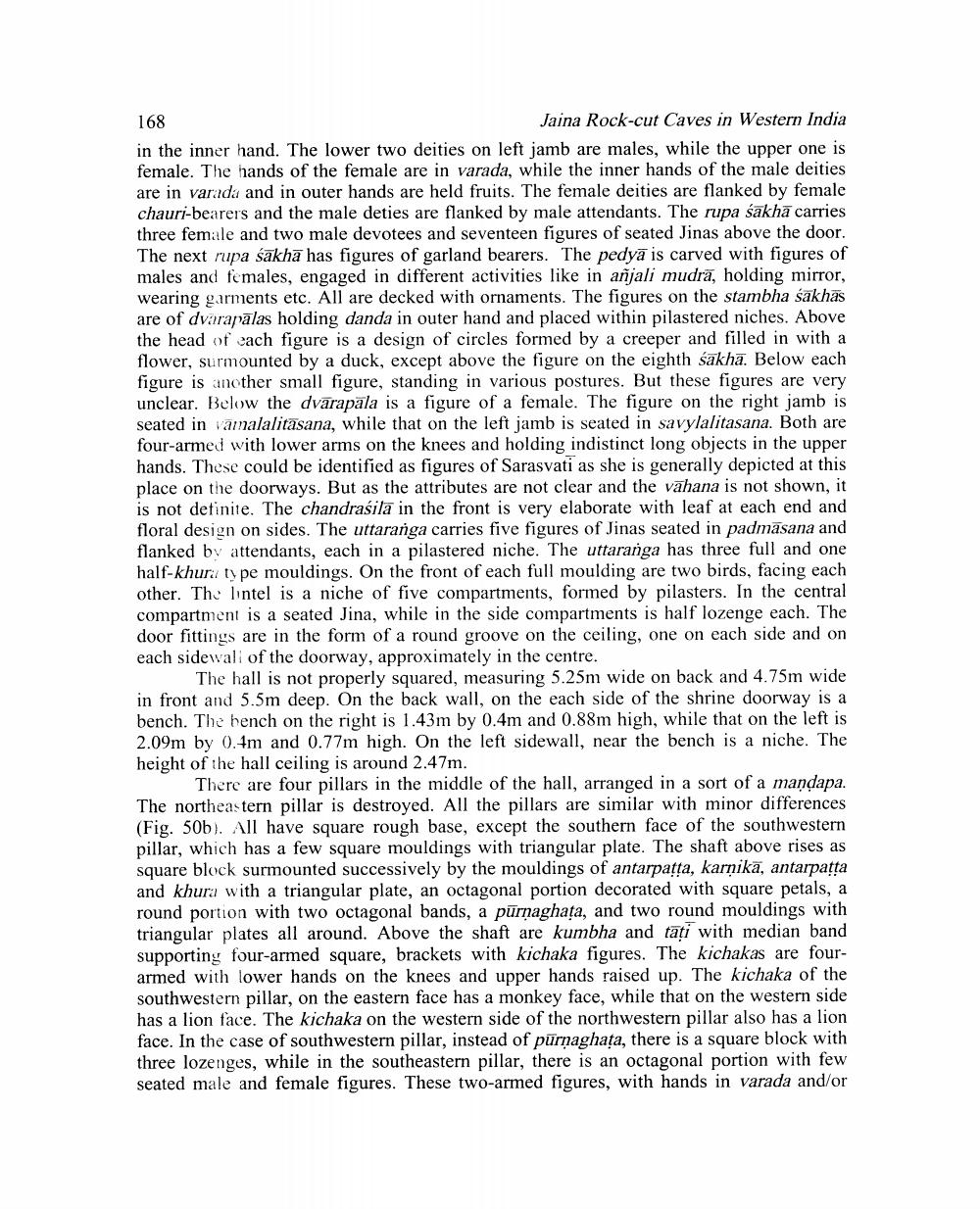________________
168
Jaina Rock-cut Caves in Western India in the inner hand. The lower two deities on left jamb are males, while the upper one is female. The hands of the female are in varada, while the inner hands of the male deities are in varada and in outer hands are held fruits. The female deities are flanked by female chauri-bearers and the male deties are flanked by male attendants. The rupa sakhā carries three female and two male devotees and seventeen figures of seated Jinas above the door. The next rupa śakhā has figures of garland bearers. The pedyā is carved with figures of males and females, engaged in different activities like in añjali mudra, holding mirror, wearing garments etc. All are decked with ornaments. The figures on the stambha sakhas are of dvarapālas holding danda in outer hand and placed within pilastered niches. Above the head of each figure is a design of circles formed by a creeper and filled in with a flower, surmounted by a duck, except above the figure on the eighth śakhā. Below each figure is another small figure, standing in various postures. But these figures are very unclear. Below the dvarapala is a figure of a female. The figure on the right jamb is seated in vamalalitasana, while that on the left jamb is seated in savylalitasana. Both are four-armed with lower arms on the knees and holding indistinct long objects in the upper hands. These could be identified as figures of Sarasvati as she is generally depicted at this place on the doorways. But as the attributes are not clear and the vahana is not shown, it is not detinite. The chandrašila in the front is very elaborate with leaf at each end and floral design on sides. The uttaranga carries five figures of Jinas seated in padmāsana and flanked by attendants, each in a pilastered niche. The uttaranga has three full and one half-khuru type mouldings. On the front of each full moulding are two birds, facing each other. The lintel is a niche of five compartments, formed by pilasters. In the central compartment is a seated Jina, while in the side compartments is half lozenge each. The door fittings are in the form of a round groove on the ceiling, one on each side and on each sidewali of the doorway, approximately in the centre.
The hall is not properly squared, measuring 5.25m wide on back and 4.75m wide in front and 5.5m deep. On the back wall, on the each side of the shrine doorway is a bench. The hench on the right is 1.43m by 0.4m and 0.88m high, while that on the left is 2.09m by 0.4m and 0.77m high. On the left sidewall, near the bench is a niche. The height of the hall ceiling is around 2.47m.
There are four pillars in the middle of the hall, arranged in a sort of a mandapa. The northeastern pillar is destroyed. All the pillars are similar with minor differences (Fig. 50b). All have square rough base, except the southern face of the southwestern pillar, which has a few square mouldings with triangular plate. The shaft above rises as square block surmounted successively by the mouldings of antarpatta, karņika, antarpatta and khuru with a triangular plate, an octagonal portion decorated with square petals, a round portion with two octagonal bands, a pürnaghata, and two round mouldings with triangular plates all around. Above the shaft are kumbha and tați with median band supporting four-armed square, brackets with kichaka figures. The kichakas are fourarmed with lower hands on the knees and upper hands raised up. The kichaka of the southwestern pillar, on the eastern face has a monkey face, while that on the western side has a lion face. The kichaka on the western side of the northwestern pillar also has a lion face. In the case of southwestern pillar, instead of pürnaghata, there is a square block with three lozenges, while in the southeastern pillar, there is an octagonal portion with few seated male and female figures. These two-armed figures, with hands in varada and/or




